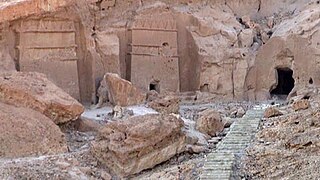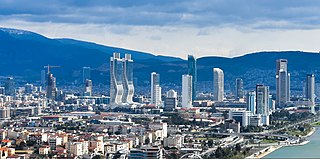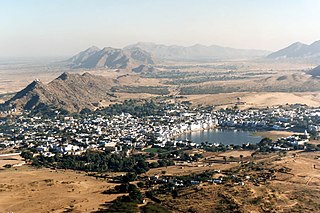Related Research Articles

Kurdistan, or Greater Kurdistan, is a roughly defined geo-cultural territory in Western Asia wherein the Kurds form a prominent majority population and the Kurdish culture, languages, and national identity have historically been based. Geographically, Kurdistan roughly encompasses the northwestern Zagros and the eastern Taurus mountain ranges.

James Gall was a Scottish clergyman who founded the Carrubbers Close Mission. He was also a cartographer, publisher, sculptor, astronomer and author. In cartography he gives his name to three different map projections: Gall stereographic; Gall isographic; and Gall orthographic.

Sir William Mitchell Ramsay FBA was a Scottish archaeologist and New Testament scholar. By his death in 1939 he had become the foremost authority of his day on the history of Asia Minor and a leading scholar in the study of the New Testament.

Haridwar is a city and municipal corporation in the Haridwar district of Uttarakhand, India. With a population of 228,832 in 2011, it is the second-largest city in the state and the largest in the district.

A gazetteer is a geographical dictionary or directory used in conjunction with a map or atlas. It typically contains information concerning the geographical makeup, social statistics and physical features of a country, region, or continent. Content of a gazetteer can include a subject's location, dimensions of peaks and waterways, population, gross domestic product and literacy rate. This information is generally divided into topics with entries listed in alphabetical order.

Midian is a geographical region in Western Asia mentioned in the Hebrew Bible and Quran. William G. Dever states that biblical Midian was in the "northwest Arabian Peninsula, on the east shore of the Gulf of Aqaba on the Red Sea", an area which contained at least fourteen inhabited sites during the Late Bronze and early Iron Ages.

İzmir Province is a province and metropolitan municipality of Turkey in western Anatolia, situated along the Aegean coast. Its capital is the city of İzmir, which is in itself composed of the province's central 11 districts out of 30 in total. To the west, it is surrounded by the Aegean Sea, and it encloses the Gulf of Izmir. Its area is 11,973 square kilometres, with a population of 4,425,789 in 2021. The population was 3,370,866 in 2000. Neighboring provinces are Balıkesir to the north, Manisa to the east, and Aydın to the south. The traffic code of the province is 35.

Lake Mansarovar, also called Mapam Yutso locally, is a high altitude freshwater lake fed by the Kailash Glaciers near Mount Kailash in Burang County, Ngari Prefecture, Tibet Autonomous Region, China. The lake along with Mount Kailash to its north are sacred sites in four religions: Hinduism, Jainism, Buddhism and Bön.

Pushkar is a city, near Ajmer City and headquarters of Pushkar tehsil in the Ajmer district in the Indian state of Rajasthan. It is situated about 10 km (6.2 mi) northwest of Ajmer and about 150 kilometres (93 mi) southwest of Jaipur. It is a pilgrimage site for Hindus and Sikhs. Pushkar has many temples. Most of the temples and ghats in Pushkar are from the 18th century and later, because many temples were destroyed during Muslim conquests in the area. Subsequently, the destroyed temples were rebuilt. The most famous among Pushkar temples is the red spired Brahma Temple. It is considered a sacred city by the Hindus particularly in Shaktism, and meat and eggs consumption are forbidden in the city. Pushkar is located on the shore of Pushkar Lake, which has many ghats where pilgrims bathe. Pushkar is also significant for its Gurdwaras for Guru Nanak and Guru Gobind Singh. One of the bathing ghats is called Gobind ghat built by the Sikhs in the memory of Guru Gobind Singh.
In ancient Canaanite religion, Ba'al Hermon was the titular local deity of Mount Hermon. The mountain was inhabited by the Hivites.
Magnesia ad Sipylum was a city of Lydia, situated about 65 km northeast of Smyrna on the river Hermus at the foot of Mount Sipylus. The city should not be confused with its older neighbor, Magnesia on the Maeander, both founded by colonists from the Greek region of Magnesia.

Laodicea on the Lycus was an ancient city in Asia Minor, now Turkey, on the river Lycus (Çürüksu). It was located in the Hellenistic regions of Caria and Lydia, which later became the Roman Province of Phrygia Pacatiana. It is now situated near the modern city of Denizli.

Aydın is a city in and the seat of Aydın Province in Turkey's Aegean Region. The city is located at the heart of the lower valley of Büyük Menderes River at a commanding position for the region extending from the uplands of the valley down to the seacoast. Its population was 207,554 in 2014. Aydın city is located along a region which was famous for its fertility and productivity since ancient times. Figs remain the province's best-known crop, although other agricultural products are also grown intensively and the city has some light industry.
Shalishah or Baal-Shalisha is a place of uncertain identification mentioned in the Book of Kings and the Talmud.
Robert Fleming the elder was a Scottish Presbyterian Minister. Following the Restoration of King Charles II, he declined to accept the authority of the newly imposed bishops in the Kirk. He was therefore ejected as minister at Cambuslang. For the next ten years he remained in Scotland, preaching as he had opportunity. In 1669 he published the first part of Fulfilling of the Scripture in Rotterdam; it was later expanded to 3 parts and it is for this work and other treatises that Fleming is chiefly remembered. On 3 September 1672 he declined indulgence at Kilwinning, disobeyed a citation of the Privy Council, and fled to London, where his Scottish speech somewhat marred his usefulness. On 30 December 1677 he was admitted colleague to John Hog, minister of the Scots Kirk, Rotterdam. After the Revolution he might have been restored to Cambuslang, but preferred to remain in Holland. While on a visit to London, he died of fever, 25 July 1694, after a short illness. Daniel Burgess preached at his funeral and also recorded some memoirs of Fleming's life.
John Parker Lawson was a minister or deacon of the Episcopal Church of Scotland and an ecclesiastical historian.

The royal Tetraevangelia of Ivan Alexander is an illuminated manuscript Gospel Book in middle Bulgarian, prepared and illustrated in 1355–1356 for Tsar Ivan Alexander of the Second Bulgarian Empire. The manuscript is regarded as one of the most important manuscripts of medieval Bulgarian culture. The manuscript, now in the British Library, contains the text of the Four Gospels illustrated with 366 miniatures and consists of 286 parchment folios, 33 by 24.3 cm in size.

Joseph Angus was an English Baptist minister, college head, and biblical scholar.
Durbuk or Darbuk, is a village and the headquarters of the eponymous subdivision and block in the Leh district of Ladakh, India. It is located in the Durbuk tehsil, and falls between Chang La mountain pass and Tangste village on the way to Pangong Tso Lake.
References
- ↑ Fleming, William (1838). The Scripture Gazetteer: A Geographical, Historical, and Statistical Account of the Empires, Kingdoms, Countries, Provinces, Cities, Towns, Villages, Mountains, Valleys, Seas, Lakes, Rivers, &c Mentioned in the Old and New Testaments: Their Ancient History, Natural Productions, and Present State : with an Essay on the Importance and Advantage of the Study of Sacred Geography. Edinburgh Printing and Publishing Company.
- ↑ Fleming, William (1838). The Scripture Gazetteer: A Geographical, Historical, and Statistical Account of the Empires, Kingdoms, Countries, Provinces, Cities, Towns, Villages, Mountains, Valleys, Seas, Lakes, Rivers, &c Mentioned in the Old and New Testaments: Their Ancient History, Natural Productions, and Present State : with an Essay on the Importance and Advantage of the Study of Sacred Geography. Edinburgh Printing and Publishing Company.
- ↑ Pullan, Leighton (1896). Lectures on Religion. Longmans, Green.
- ↑ Lightfoot, Joseph Barber (1885). The Apostolic Fathers ... Macmillan and Company.
- ↑ Welton, William (1848). A Synopsis of the ecclesiastical history of the three first centuries of the Christian Era, down to the General Council at Nice. [By W. Welton.]. J. Hall.